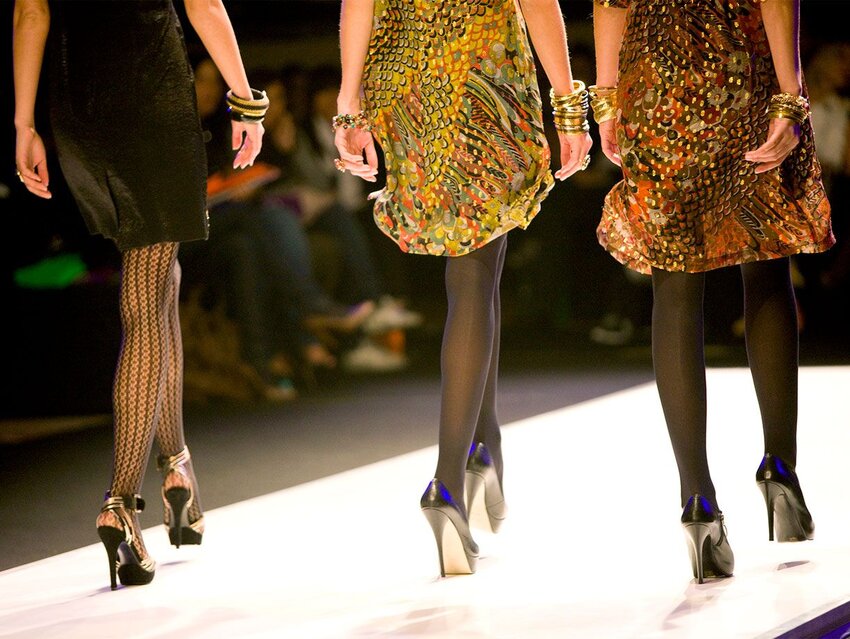"Come on, vogue
Let your body move to the music…"
So begins the chorus of Madonna's enduring 1990 No. 1 hit "Vogue," a word that evokes mental images of lithe models and designer handbags, towering stilettos and glossy magazine pages. The Oxford English Dictionary defines the word as a noun, adjective, and verb, all of them having to do with "the prevailing fashion or style of a particular time."
The word itself comes from the Romance languages, the French verb voguer or the Italian voga, both of which mean to "row, sail, or go well." Its connotation with fashion did not appear until the late 16th century in French, "in the vogue." But what does that have to do with sailing? It relates to the state of being "borne along by the tide of a trend," the way shoppers followed the Kardashians down the athleisure rabbit hole, or how today's teens are recycling the low-rise pants of the early aughts.
In the Vogue
What first comes to mind for many people when they hear the word "vogue" is the high-fashion magazine of the same name, which published its first issue in 1892, approximately 300 years after the French began associating the word with fashion. The introduction of Vogue magazine, and its quick establishment as the arbiter of taste, cemented the fashionable association to the word.
Google Ngrams shows a huge spike in the word's usage around 1900 through 1920, when the nascent magazine grew in popularity. Although it always emphasized and, in many ways, sought to define the standards of feminine beauty, many credit Editor-in-Chief Anna Wintour's takeover in 1988 for the magazine’s shift from close-up portraiture to a greater emphasis on the whole female form. Vogue and Anna Wintour remain a powerful force in fashion culture, despite the shift from print to digital media; in many ways, given that fashion is a visual medium, it allows a seamless transition to platforms like Instagram or TikTok, which rely heavily on visual content.
At present it's common to refer to a certain fashionable and current style, behavior, or trend as "in vogue" or "in the vogue," though the French en vogue is also acceptable. Likewise, one might refer to something unfashionable or otherwise gauche as "out of vogue." The concept itself plays out in more rudimentary language in the form of "in/out" lists found in contemporary magazines, a ubiquitous example being New York magazine's "Approval Matrix."
Let Your Body Move to the Music
“Vogue” as a verb originated in the LGBTQIA+ community, namely the Black and Latinx queer community of Harlem. In the 1960s through the 1980s, underground "ballroom" culture began to flourish in New York City. The first balls date back to the late 19th century, in 1867, when the first "Odd Fellows Ball" was held at Harlem's Hamilton Lodge No. 710, where men and women "gathered to dress in drag and compete as the most convincing impersonator of the opposite gender," a concept that eventually developed into the slang term "realness."
The documentary Paris Is Burning (1990) and, later, the FX series Pose (2018-2021) brought the drag ballroom scene into popular consciousness, but it began with Crystal LaBeija in the 1960s. So-called "houses" (chosen families of LGBTQIA+ individuals) would compete for trophies in a variety of categories involving dance, beauty, fashion, and more. The trademark dance style, involving stiff, angular posing that aligns with the beat of a song, came to be known as “voguing.”
According to DJ David DePino, the dance style was invented at Footsteps, an after-hours club in the early 1970s. He said that Paris DuPree, of the House of DuPree, pulled a Vogue magazine out of her bag while she danced, and "opened it to a page where a model was posing and then stopped in that pose on the beat. Then she turned to the next page and stopped in the new pose, again on the beat. … At first they called it posing and then, because it started from Vogue magazine, they called it voguing."
Beauty's Where You Find It
How did voguing make it from NYC's queer community to the top of the Billboard charts? A 1989 Time magazine article declared it the new break dancing, which likely helped it enter the mainstream lexicon even before the Madonna song came out. Madonna became aware of the trend through her longtime association with NYC gay culture, and through the video for Malcolm McLaren's track "Deep in Vogue," which hit the top of the Billboard dance music chart in 1989.
The McLaren video showcased ballroom talent, featuring a performance from Willi Ninja, of the House of Ninja. Voguing also began to appear on the catwalks of French fashion designers Thierry Mugler and Jean-Paul Gaultier, but it was at the 1989 AIDS fundraiser "The Love Ball," which featured Madonna, that the mainstream breakthrough really occurred. Only weeks later, Madonna met Jose Gutierez Xtravaganza (House of Xtravaganza) at the Sound Factory in New York City, where she asked him to teach her to vogue, and ultimately to choreograph the music video for her song “Vogue.”
The song's lyrics harken back to Old Hollywood glamour; Madonna invokes the names of Marilyn Monroe and Marlene Dietrich, among many others. This serves to associate extravagant beauty and opulence with the sumptuous performance style of voguing, and to illustrate the type of beauty ideals that drag ballroom culture sought to emulate.
Featured image credit: webphotographeer/ iStock

